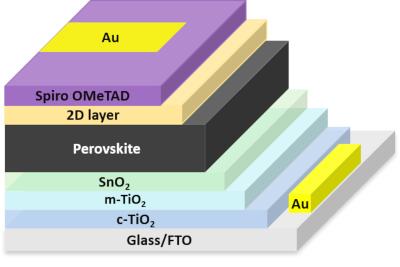An international research team that includes scientists from EPFL in Switzerland, Middle East Technical University (METU) in Turkey, Lomonosov Moscow State University in Russia and The University of Tokyo has fabricated a quasi-2D perovskite solar cell with a unique type of salt to enhance hole extraction.
The triple-cation perovskite absorber was treated with phenethylammonium iodide (PEAI), a modulator that alters the perovskite film's surface energy and forms a quasi-2D structure without further annealing. The result is a 23.08%-efficient device that is also able to retain 95% of its initial efficiency after 900 hours.
The researchers stated that they are currently planning to set up an experimental production line in Turkey, that could be operational as soon as 2025.
For their 3D/2D solar cell, the team used three organic ammonium salts: 2-methoxy-PEAI (o-OMe-PEAI), 3-methoxy-PEAI (m-OMe-PEAI), and 4-methoxy-PEAI (p-OMe-PEAI). They built the device with a fluorine-doped tin oxide (FTO) substrate, a commercially pure titanium oxide (cp-TiO2) electron transport layer, a mesoporous titanium dioxide (mp-TiO2) layer, a tin(IV) oxide (SnO2) buffer layer, the perovskite layer, the OMe-PEAI layer, a spiro-OMeTAD hole transport layer, and a gold (Au) metal contact.
The team described the process, saying that a solution of methoxy-substituted salts in isopropanol (IPA) was coated on it by spin coating to form the 3D/2D perovskite structure. Perovskite films treated with methoxy-substituent salts tend to have fewer bright grains on the surface, indicating that OMe-PEAI salts react with excess lead(II) iodide (PbI2) on the 3D perovskite surface.
The resulting solar cell achieved a power conversion efficiency of 23.08%, an open-circuit voltage of 1.120 V, a short-circuit current of 25.55 mA/cm2, and a fill factor of 80.6%. A reference cell without the PEAI treatment reached an efficiency of 20.86%, an open-circuit voltage of 1.091 V, a short-circuit current of 24.55 mA/cm2, and a fill factor of 78.0%.
According to the team, all 3D/2D PSCs treated with methoxy-substituted salts showed lower hysteresis than the reference solar cell, indicating suppressed ion migration and accumulation by passivating the defects on the perovskite surface. The champion device retained 95% of its initial efficiency after 900 hours, while the reference cell maintained only 49%.
The unique orientation of the o-OMe-PEAI on the 3D perovskite surface revealed higher hydrophobicity compared with other salts, which in turn reflected the higher stability of the resulting devices.




